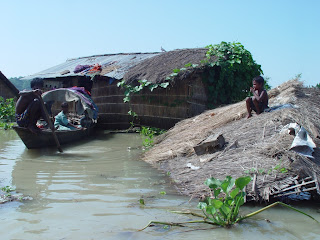The flood problem in Brahmaputra and Barak valleys:
The flood problem in Brahmaputra and Barak valleys has three main facets. First, the problem is of inundation of the riverine areas due to spilling of banks by the main river and by tributaries. Second, the problem of drainage congestion specially at the outfalls of tributaries during high stages of rivers. Third, the problem is of bank erosion and channel instability due to excessive sediments. The Brahmaputra and tributaries flow in high stages during monsoon months spilling the banks causing floods. In cases when the river Brahmaputra is in high stage and the tributaries are flowing within the bank, drainage congestion at the outfall causes flood. In cases when the main river and the tributaries are all in spate simultaneously, the situation becomes most critical due to inundation of 30 to 40% of land susceptible to flood damage. The Brahmaputra valley in Assam only accounts for 95% of total flood prone area of North Eastern region and 9.5% of the country’s total. The heavy rainfall in the valley during monsoon aggravates flooding of countryside agricultural land due to submergence and at times habituating places. The early period (April and May) rainfall is absorbed by moist free soil and causing less flood menace. The rainfall from June to October ranging from 1500 mm to 1750 mm causes river flowing in high stages with floods. Floods in the river basin are also caused by rainstorms which are generally associated with low pressure system like marked low, cyclones or tropical cyclones. During past 100 years over 1000 tropical cyclones and depression in Bay of Bengal and Arabian Sea moved across the Indian sub-continent. Passage of such storms in guide succession over Brahmaputra basin invariably leads to severe floods. Cyclonic circulation during monsoon too sometimes leads to flood. Rainfall on such occasion continue for 1 day , 2 day or 3 day resulting 250-590 mm, 430-800 mm and 450mm to 900 mm respectively causing major floods inundating a large area. The hue and cry starts when the people in the riverine area unable to harvest their crops and also cultivate the seasonal crops. As much as 70 % of the flood loss in Assam as accounted for is in Agriculture sector. Drainage congestion aggravates the situation by submerging the low lying areas even suitable for cropping due to heavy rainfall in the valley.
N.B. This article is collected from various sources; original data may be different from this.






No comments:
Post a Comment